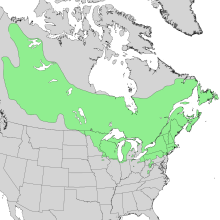Alnus hirsuta var. microphylla
| Alnus incana | |
|---|---|
 |
|
| Speckled alder Alnus incana subsp. rugosa | |
| Scientific classification | |
| Kingdom: | Plantae |
| (unranked): | Angiosperms |
| (unranked): | Eudicots |
| (unranked): | Rosids |
| Order: | Fagales |
| Family: | Betulaceae |
| Genus: | Alnus |
| Subgenus: | Alnus |
| Species: | A. incana |
| Binomial name | |
|
Alnus incana (L.) Moench |
|
 |
|
| A. incana complex range | |
 |
|
| A. incana subsp. incana range | |
 |
|
| A. incana subsp. rugosa range | |
 |
|
| A. incana subsp. tenuifolia range | |
Alnus incana (grey alder or speckled alder) is a species of alder with a wide range across the cooler parts of the Northern Hemisphere.
It is a small to medium size tree 15–20 m (49–66 ft) tall with smooth grey bark even in old age, its life span being a maximum of 60 to 100 years. The leaves are matte green, ovoid, 5–11 cm (2.0–4.3 in) long and 4–8 cm (1.6–3.1 in) broad. The flowers are catkins, appearing early in spring before the leaves emerge, the male catkins pendulous and 5–10 cm (2–4 in) long, the female catkins 1.5 cm (0.6 in) long and one cm broad when mature in late autumn. The seeds are small, 1–2 mm (0.04–0.08 in) long, and light brown with a narrow encircling wing. The grey alder has a shallow root system, and is marked not only by vigorous production of stump suckers, but also by root suckers, especially in the northern parts of its range. The wood resembles that of the black alder, but is somewhat paler and of little economic value.
There are four to six subspecies, some treated as separate species by some authors:
Alnus incana is a light-demanding, fast-growing tree that grows well on poorer soils. In central Europe, it is a colonist of alluvial land alongside mountain brooks and streams, occurring at elevations up to 1,500 metres (4,900 ft). However, it does not require moist soil, and will also colonize screes and shallow stony slopes. In the northern part of its range, it is a common tree species at sea level in forests, abandoned fields and on lakeshores. It is sometimes used for afforestation on non-fertile soils which it enriches by means of nitrogen fixing bacteria in its root nodules. Several species of Lepidoptera use grey alder as a food plant for their caterpillars. See List of Lepidoptera that feed on alders. In the Boreal forest area of Canada, A. incana is often associated with black spruce in the forest type termed black spruce/speckled alder.
...
Wikipedia
